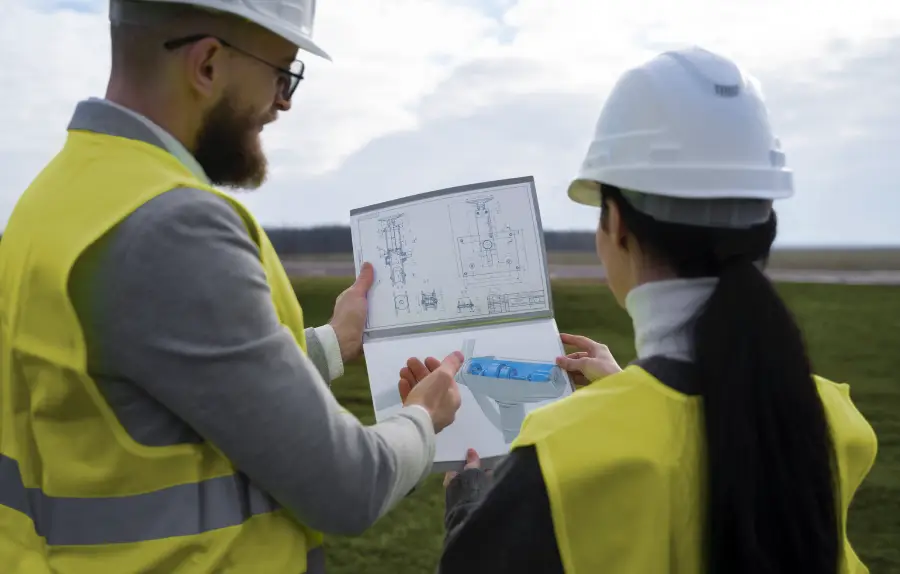What is a site survey? In civil engineering and construction, it is the detailed study of a piece of land to understand its conditions before any project begins. By analyzing topography, soil, infrastructure, and environmental factors, a site survey equips engineers and planners with the data they need to design projects safely and effectively.
What is a Site Survey?
So, what is a site survey? In civil engineering and construction, a site survey is a systematic examination and measurement of land to collect data about its physical, environmental, and infrastructural features. The survey goes beyond mapping boundaries; it provides detailed insights into factors that influence whether a project is feasible, safe, and cost-effective.
Goals of a Site Survey
The primary goals of conducting a site survey include:
- Evaluating site conditions such as terrain, soil, and drainage.
- Identifying opportunities and constraints that may affect design.
- Providing accurate data for engineers, architects, and planners.
- Reducing risks and uncertainties before construction begins.
In short, the purpose of a site survey is to transform raw land into actionable data that supports informed project decisions.

Key Components of a Site Survey
A thorough site survey evaluates multiple aspects of the land, many of which are critical to engineering and construction.
Topography
Surveys record slopes, contours, and elevations to show how water flows and how structures should be positioned. This is the same process used in a topographic survey, which focuses on mapping the shape of the land in detail.
Geology and Soil Conditions
Understanding the ground beneath the surface is essential. If soils are weak or expansive, they can create foundation challenges—a focus of geotechnical engineering.
Infrastructure
Existing infrastructure—such as roads, utilities, drainage systems, and nearby buildings—affects how the new project will integrate with its surroundings.
Environmental Factors
Site surveys also flag features like wetlands, flood zones, and habitats. In some cases, surveys are tied to wetland delineation studies or even conservation easements that regulate land use.
Data Analysis and Reporting in Site Survey
Collecting data in the field is only the beginning. A site survey becomes valuable once the information is analyzed and translated into usable outputs.
Surveyors use tools like CAD (Computer-Aided Design), GIS (Geographic Information Systems), and 3D modeling software to process the raw measurements. The results are presented in formats such as:
- Topographic maps with contours and spot elevations.
- Site analysis reports outlining soil conditions, drainage patterns, and constraints.
- Digital terrain models (DTMs) for advanced design and simulations.
These deliverables allow project teams to visualize the site, understand its limitations, and plan accordingly. Clear reporting also ensures that stakeholders,from engineers to investors, are aligned in their understanding of site conditions.
Applications of Site Surveys
Site surveys play a role in nearly every field that involves land use, development, or construction.
Construction and Engineering
Site surveys provide the foundation for building design, excavation planning, foundation engineering, and infrastructure placement. They help ensure that structures are safe, stable, and appropriately located.
Architecture and Urban Planning
Architects and planners rely on survey data to design buildings, neighborhoods, and cities that harmonize with the landscape. Elevations, access points, and environmental constraints shape how projects are envisioned and executed.
Environmental Assessments
Environmental Assessments – Surveys identify wetlands, flood risks, and ecological constraints. They often support environmental site assessments and remediation planning.
Risk Identification
By revealing hidden challenges—such as unstable soil, underground utilities, or flood-prone areas. Site surveys reduce the likelihood of costly mistakes and delays during construction.
Types of Site Surveys
Site surveys come in several forms, depending on the scope and objectives of the project.
- Topographic surveys: Focus on mapping elevations and contours of the land.
- Geotechnical surveys: Examine soil and rock conditions for foundation design.
- Boundary surveys: Establish legal property lines and ownership boundaries.
- Environmental surveys: Assess ecological features, wetlands, and habitats.
- Utility surveys: Locate and map underground utilities to avoid construction conflicts.
Understanding the types of site surveys ensures that the right approach is chosen for each project, whether it’s a small residential build or a large-scale infrastructure project.
Importance of Site Survey in Civil Engineering
The importance of site surveys lies in its ability to bridge the gap between concept and construction. Without reliable site data, even the best designs can fail in execution.
Why Site Surveys Matter
- They reduce risk by identifying challenges early.
- They ensure compliance with zoning, safety, and environmental regulations.
- They guide design decisions, making projects safer and more efficient.
- They save time and money by minimizing unexpected delays and costly redesigns.
For civil engineers, site surveys aren’t just a preliminary step, they are the blueprint for making informed, practical, and sustainable design choices.

Conclusion
So, what is a site survey? It is the systematic assessment of land conditions to provide engineers, architects, and planners with the information they need to design and build responsibly. By examining topography, soil, infrastructure, and environmental factors, site surveys transform raw land into usable data.
The purpose of a site survey is to evaluate a site’s opportunities and constraints, while its importance lies in reducing risk, guiding design, and ensuring project feasibility. With different types of site survey available, professionals can choose the right method for each project, ensuring safe, cost-effective, and sustainable outcomes.
